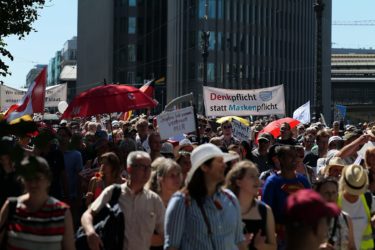The historian Robert of Avesbury is known principally for his very detailed accounts of the mid-fourteenth century Anglo-French Wars – well worth reading should you ever find yourself short of valium. On a more fascinating note, he also left us an eyewitness account of some Continental ‘flagellants’, active in London in the autumn of 1349.
Several hundred men had arrived from an area now in the Belgium/Netherland borders:
“Sometimes at St Paul’s and sometimes at other points in the city they made two daily public appearances … Each had in his right hand a scourge with three tails. Each tail had a knot and through the middle of it there were sometimes sharp nails fixed. They marched naked in a file one behind the other and whipped themselves with these scourges on their naked and bleeding bodies … every night they performed the same penance.”
The key to understanding Robert’s masochistic tourists is the timing: the Black Death had arrived in Sicily in 1347 and spent the subsequent years making its grim progress around Europe. A generation’s equilibrium, their faith in established religious ideas and institutions had been deeply challenged, or even disappeared entirely. For flagellants, the new Deal-With-God meant punishing themselves before He could get to them.

Flagellants were violently anti-Semitic and this trait became more pronounced as time wore on, probably because a “younger, poorer, more criminal, ignorant”(p 267) intake came to dominate. Jews had been scapegoated for decades prior to the epidemic, as Europe had experienced a long-slide downwards in living conditions (due to climate change and over-population). But the crunch really came with the plague. Centuries old conspiracy theories like well-poisoning Jews or those who sacrificed Christian children for occult purposes became endemic. It is reckoned that the era’s first violent pogrom happened at Chillon, France in 1348. Shortly afterwards the Jewish communities of Solothurn, Burren, Memmingen, and Lindau were rounded-up and burned alive. It continued: you’ll find the details in any decent history book of the era.
The blame for cholera outbreaks in Europe during the nineteeth century were usually placed on the sufferers themselves because they were filthy (as though they had a choice). But in an interesting reversal the poor sometimes thought the disease a plot of the governing classes to kill them. The 1918-20 ‘Spanish’ influenza (which actually came from Kansas) was thought by some to have been developed as a war-pathogen by Germany, and the KGB was known to have spread misinformation at the beginning of the AIDS epidemic, to the effect that it had been developed by the USA as a biological weapon.
So it would be weird if we didn’t have our own outbreaks of misdirected paranoia during COVID-19. The 5G network has been the biggest scapegoat: there is no disease but the new network has created symptoms; there is no disease and lockdown was to keep us at home while the government installed nefarious technology without supervision; there is a disease and 5G makes it worse. As the fact-checking website FullFact says: “as the pandemic accelerated, and measures limiting public freedoms in the UK became more extreme, so did the claims”.
Assaults on telecoms workers have even occurred. Researchers at Newcastle University found that “belief in 5G COVID‐19 conspiracy theories was… associated with a greater justification of real‐life and hypothetical violence in response to an alleged link between 5G mobile technology and COVID‐19, alongside a greater intent to engage in similar behaviours in the future”.
As skeptics we are already familiar with the traits that make people more likely to be conspiracy theorists. For example, there is ‘teleological bias’ – the tendency to look for a purposeful meaning behind unrelated events. Teleological thinkers ask the question “why” instead of the question “how”. They tend to see an agent or intelligence behind things. Thinking teleologically comes more naturally than thinking analytically, especially when your cognitive bandwidth is low – when you are stressed, in other words. It allows the possibility that there is a force to either fight or reason with: better than trying to reason with blind bad luck, after all.
Conspiracy theorists are also more likely to be socially isolated, and social isolation has been a feature of lockdown. They usually also have an increased tendency to see patterns; in normal doses, we call this ‘apophenia’. In larger doses, we call it paranoia.
As skeptics, we should also be aware that these are traits shared to some degree by all of us, and that our approach to the world varies according to the stresses we are under. Like the anti-Semitism of medieval Europe, 5G conspiracies have not emerged, fully-formed, from the ether; they have just surged in popularity among the general public while the world got weirder. There is plenty of evidence that anti-vaccination and alt-med networks were ready partakers of the 5G delusions. People can talk to each other very easily on the internet, and they don’t always say sensible things.
So let’s hope that we get a vaccination very soon so life can go back to normal.

Except that it may not be that easy. Censolo and Morelli discuss the idea of “epidemics as incubators of more serious social disorders”. It may be that social and economic restrictions stoke “latent sentiment of public discontent” which are “the symptom of potentially dangerous frictions inside society”.
They consider several factors during epidemics which can exacerbate social dischord. These are also recognisable as promoters of conspiracy theories. The first is loss of agency, that authorities inflict measures which “tend to conflict with the interest of people”. The second is that where the epidemic “impacts differently on society in terms of mortality and economic welfare, it may exacerbate inequality”. The third is that “psychological shock may induce irrational narratives on the causes and the spread of the disease, which may result in social, racial discrimination and even xenophobia”.
So perhaps we should start to look at conspiracy theories as indicators of rising social tension rather than just foolish or malignant entities of their own. 2020 has been spent contemplating COVID-19 so intensely that we may have forgotten about the rising wealth inequality and climate change to come.



